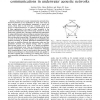Free Online Productivity Tools
i2Speak
i2Symbol
i2OCR
iTex2Img
iWeb2Print
iWeb2Shot
i2Type
iPdf2Split
iPdf2Merge
i2Bopomofo
i2Arabic
i2Style
i2Image
i2PDF
iLatex2Rtf
Sci2ools
133
Voted
AINA
2009
IEEE
2009
IEEE
Multi-node Processing for Asymmetrical Communications in Underwater Acoustic Networks
— Underwater acoustic communication networks have attracted attention for its applications in many areas such as mine warfare, rapid environmental assessment or search and rescue, where there is the need for conserted action of a group of observers/actuators. A common requirement in most of these applications is the need to make accessible to the global (terrestrial/aerial) user network large amounts of critical underwater collected data. This paper addresses this requirement by using multichannel nodes providing an asymmetrical point-topoint (P2P) connection where the upload link has a much higher data rate than the download link. The emphasis of this work is not so much on the final channel throughput but on establishing the optimal processing of spatially distributed multichannel nodes that serve as interface between the underwater nodes and the global/user network. The adopted strategy relies on passive time-reversal which can be viewed as a spatial pre-equalizer for each multic...
AINA 2009 | Computer Networks | Multichannel Node | Underwater Acoustic Communication | Underwater Nodes |
Related Content
| Added | 18 May 2010 |
| Updated | 18 May 2010 |
| Type | Conference |
| Year | 2009 |
| Where | AINA |
| Authors | Antonio Silva, Julien Huillery, Sergio M. Jesus |
Comments (0)

